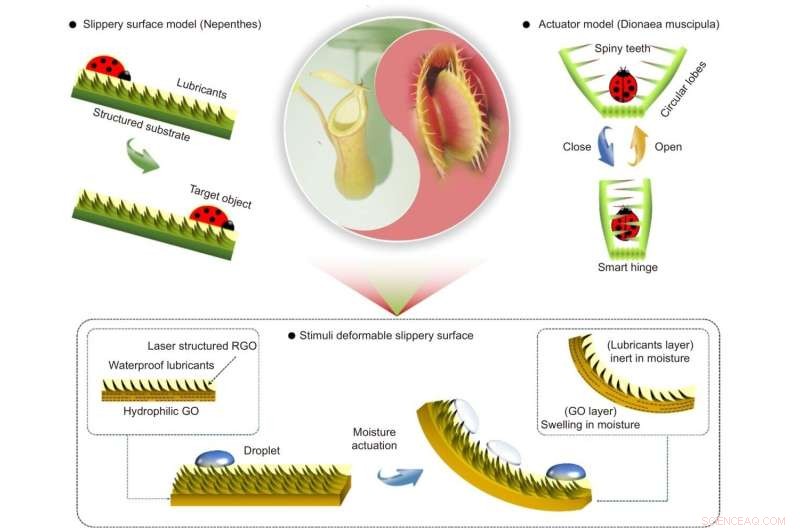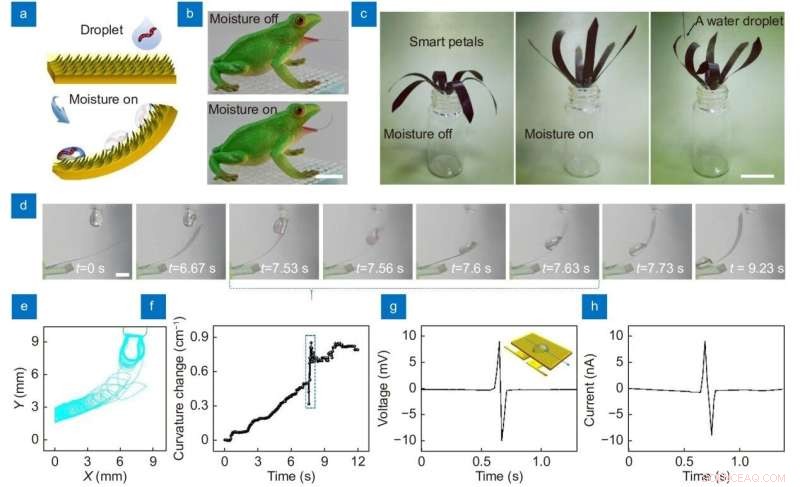
Concept de base d'une surface glissante hybride bionique sensible à l'humidité, inspirée des plantes carnivores multiformes. La sarracénie pourpre Nepenthes attrape passivement les insectes à l'aide d'une surface glissante infusée de lubrifiant. La Dionaea muscipula se nourrit activement grâce à un mécanisme d'actionnement sensible aux stimuli. Nous avons combiné les surfaces glissantes (proies passives) et l'actionnement sensible aux stimuli (proies actives), nous avons donc proposé un GO hybride à base de surface glissante déformable par l'humidité bionique, qui permet la manipulation active et passive des gouttelettes. GO :oxyde de graphène; RGO, GO réduit. Crédit :Compuscript Ltd
Une nouvelle publication de Opto-Electronic Advances explique comment les plantes carnivores inspirent les surfaces glissantes intelligentes et les robots bioniques.
Les plantes carnivores ont inspiré des innovations d'actionneurs avancés sensibles aux stimuli et de surfaces glissantes infusées de lubrifiant. Cependant, le développement de dispositifs bioniques hybrides qui combinent les capacités de piégeage actif et passif des proies des plantes carnivores reste un défi. L'équipe de recherche a développé une surface glissante sensible à l'humidité. Ils ont intégré une surface glissante infusée de lubrifiant avec un actionneur bicouche LRGO/GO. L'équipe a préparé une série d'actionneurs de preuve de concept, y compris une langue de grenouille intelligente et une fleur intelligente, démontrant le piégeage actif/passif, la manipulation des gouttelettes et la détection.
Les plantes carnivores peuvent piéger et digérer de petits insectes grâce à des mécanismes d'actionnement sophistiqués ou à une mouillabilité de surface unique. Cette capacité a inspiré le développement de surfaces/dispositifs intelligents artificiels pour des applications d'ingénierie, telles que les surfaces antigivrantes, l'anti-biofouling, la condensation des gouttelettes et la manipulation des gouttelettes. L'imitation de leurs comportements de piégeage a conduit à des stratégies innovantes pour la conception de surfaces synthétiques, d'actionneurs et de robots.
Généralement, le mécanisme de piégeage des plantes carnivores diffère selon les différentes espèces, qui peuvent être classées en deux catégories :le piégeage actif et le piégeage passif. Cependant, les dispositifs bioniques hybrides qui combinent les mérites des deux types distincts de plantes carnivores, avec des capacités de piégeage à la fois positives et passives, sont encore rares. La combinaison d'actionneurs inspirés de Dionaea muscipula avec une surface glissante qui imite l'usine de pichet Nepenthes est bénéfique à la fois pour la conception de l'actionneur et le développement d'une surface intelligente avec une super mouillabilité. Néanmoins, il est difficile d'atteindre cette fin.
Femtosecond laser direct writing (FsLDW) induced photoreduction and simultaneous structuring to prepare a GO and LRGO bilayer actuator that enables dynamic deformation under moisture actuation. After that, a lubricant-infused slippery surface was integrated with the graphene actuator by immobilizing lubricant at the LRGO side through the capillary forces.

The manipulation of droplets on moisture responsive shape-morphing slippery surface. (a) Schematic illustration for the active and passive manipulation of a droplet containing live tubificidaes using the shape-morphing slippery surface. (b) The photographs of shape-morphing slippery frog tongue. The scale bar is 1.5 cm. (c) A smart water droplet harvesting flower. Every flower petal is made of the shape-morphing slippery surface (oil-LRGO/GO). The scale bar is 1.5 cm. (d) Moisture triggered active approach to water droplets containing live tubificidaes and the passive sliding behavior on the shape-morphing slippery surface. The scale bar is 0.5 cm. (e) The corresponding trajectory of the water droplet peripheries during the dynamic process. (f) The curvature changes of the shape-morphing slippery surface in (d). (g) The open-circuit voltage and (h) short-circuit current. Crédit :Compuscript Ltd
The two types of carnivorous plants demonstrate distinct strategies for trapping prey. Nepenthes pitcher plants catch insects through a passive trapping mechanism with the help of lubricants-infused slippery surfaces. In contrast, Dionaea muscipula performs an active trapping behavior through a sophisticated actuating mechanism. The concept of the hybrid bionic model is the combination of the two tapping behaviors within one synthetic smart surface here, which the research team called a stimuli deformable slippery surface.
Traditional stimuli-responsive actuators enable reversible deformation under external stimuli. They reveal the great potential for developing trapping robots. However, in most cases, simple bending deformation cannot trap insects because of the slow response to environmental stimuli or the lack of surface wettability control. The team combined the moisture-responsive actuator with a lubricant-infused slippery surface together. The combined effect of actuation and slippery property endows the oil-infused LRGO/GO film with enhanced trapping ability.
The research team demonstrated a moisture-responsive shape-morphing slippery surface that can contact droplets actively and let them slide away passively. Based on this hybrid bionic concept, a smart frog tongue that can catch and manipulate droplets containing live tubificidaes is prepared. Notably, the slippery surface can bend under moisture actuation, get in touch with the droplet, and let it slide to the bottom, demonstrating both active catching and passive trapping capabilities.
In conclusion, the in-situ integration of the lubricant-infused slippery surface with the bilayer actuator does not degrade the actuating performance. It also improves its deformation degrees under moisture actuation. The presence of an oil layer can entirely prevent the transmission of water molecules through the LRGO side, and selective water adsorption only occurs within the GO layer. As a result, the oil-LRGO/GO actuator demonstrated large deformation curvature, short response/recovery time, and improved stability. For practical applications, laser interference ablation that uses an interference effect for periodical patterning is more effective. The significance of this work lies in the fabrication of a shape-morphing slippery surface with hybrid bionic functionalities of both stimuli-responsive deformation and oil-lubricated slippery properties.
The combination of shape-morphing ability with the slippery surface benefits both actuating performance and the usefulness of a smart surface with super wettability. It leads to new applications, such as droplet collection, manipulation, and rainfall sensing. Moisture-responsive actuators can directly harness energy from naturally occurring or engineered evaporation from water. That can subsequently be converted to mechanical energy or electricity, such as weather-responsive architectural systems, smart textiles, and soft robots. The cross-species bio-inspired materials benefit both actuator design and the development of smart surfaces with super wettability. The moisture-responsive shape-morphing slippery surface reveals great potential for developing bionic robots. Liquid-infused slippery surface performs better than superhydrophobic surface in long-term corrosion resistance